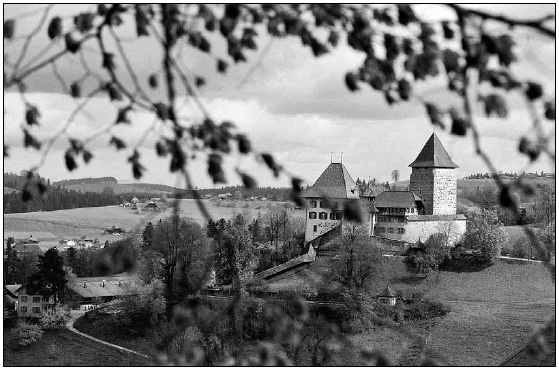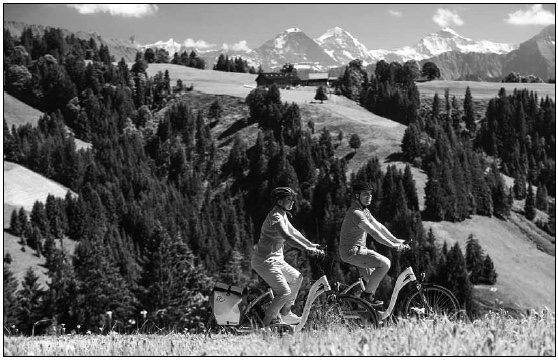“Herzroute AG” (Heart route) discovers heart of Switzerland
“Herzroute AG” (Heart route) discovers heart of Switzerland
by Heini Hofmann
A bypass can be the means of rescue for a diseased heart. But for the perfectly healthy heart route, the world’s most beautiful e-bike panorama tour (No. 99) between Lake Constance and Lake Geneva, the new additional loop around the local Napf hill (No. 399) is the icing on the cake - in both the scenic and cultural treasure chest right in the heart of Switzerland.

The Napf region is one of the most down-home Helvetian cultural landscapes. At the top of the Napf (with 1408 m altitude rather a hill than a mountain) a breathtaking 360-degree panorama opens up over long stretches of our country. Therefore, it must have seemed obvious to the heart route inventors to expand the main route crossing Switzerland with another potential-hit bypass here - similar to the already existing Lucerne-Aargau-Seetal loop.
Candidate for top destination
The rugged Napfland is characterised by harrows, hills and crests as well as star-shaped, deep ditches and gorges enlivened by spring streams and waterfalls. The erosion power of the water has here shaped the landscape so extremely because of the geology consisting mainly of “Nagelfluh”, sandstone and marl, and since the Napf territory remained largely unglaciated in the last ice age. Thanks to the new e-bike route, this natural fluvial labyrinth wonder can now be discovered in a way which is gentle to the heart.
The choice of route corresponds entirely to the pattern of the national heart route: low-traffic but well-signposted small roads, great views, picturesque villages, personal closeness to the agricultural culture, in short, an exciting mix of adventure and comfort. Whereas European river routes used to be the velocipede mega trend, there are many more demanding offers that can be taken up by anyone today, thanks to electric assistance. The Napf bypass has all the makings of becoming the top destination for e-bike tourists – like a phoenix from the ashes!
Showcase win-win project
In the meantime, the booming national heart route has established itself as a pearl in the cycling country of Switzerland. It is even qualified by Switzerland Tourism as a “cherry” in SwitzerlandMobil’s unique route network. Active holidays on two wheels are extremely popular, especially with modern outdoor tourists, who do not lower their eyes and pedal their legs stiff, but want to enjoy the wonders on the wayside while having a comfortable bike ride.
Therefore, the extension of the trendy offer was obvious. The Napf heart loop as an additional high-quality cycling experience is a joint offer of the Berne and Lucerne cantons, the regional development agencies Emmental and Entlebuch as well as of various municipalities, in cooperation with private partners. The objective is a gentle tourist revival of this unique recreational area. Beneficiaries are remote inns and “Besenbeizen” (wine taverns) as well as providers of regional specialties and touristic originalities.
Three different stages
The three stage destination towns Willisau (center of the Lucerne hinterland), Langnau (largest area municipality of the Berne canton) and Entlebuch (in the biosphere country) make up a triangle with uneven and winding sides and daily stages between 40 and 60 kilometres. The first stage on the north side of the Napf foothills leads through lovely hilly landscapes, interrupted by rugged passages. Highlights are the Luther Valley, Trachselwald Castle and Alp Lüdern.
Between Langnau and Entlebuch, the side of the Napf facing the Alps impresses with magnificent high passages and panoramic sections. Finally, on the third and last stage, between Entlebuch and Willisau, the whole drama of the Napf mountainous region is revealed, especially when riding along the Grand Fontanne or on the high altitudes of Menzberg and Luthern. Naturally, you can also circle the Napf the other way round.
On the trail of the Baptists
An impressive historical witness on the first stage is Trachselwald Castle, the last surviving dynasty castle in the Emmental above Burgdorf. In earlier times, members of the religious community of the Anabaptists, a secondary movement of the Reformation from the early 16th century, which supported adult baptism and was once widespread in the Emmental, were arrested in its keep. Their centuries-long suffering as a result of persecution is a dark chapter in history, of which the “Anabaptists Trail of Sumiswald” is a reminder.
Even today, descendants of displaced Baptists, mostly from the US, make their way to Sumiswald and visit the Haslebach farm on Chleinegg, where Hans Haslebacher, a central figure of the Anabaptists, once lived. He was executed in 1571, as the last of over 40 Anabaptists in the Canton of Berne. Incidentally, after being betrayed by a former comrade-in-law, legendary peasant leader in the Peasant War (1653), Niklaus Leuenberger was imprisoned in Trachselwald Castle before he was executed in Berne. – Different times, short shrift …
A touch of Napf Wild West
Change of scene to the famous Napf gold. It originates from the Alps and was transported by primeval rivers into the Napf region 10 to 40 million years ago. That is why still today, with some luck, most of the brooks can be used to wash the precious metal in the form of small gold leaf flakes, flat rolled, oblong or round leaflets of over 23 carats. There are also events and courses offered, in bad weather indoors, with wooden troughs with prepared sand replacing the streambed (www.goldwasch-tour.ch).
Already in Celtic times, gold was washed in the Napf area. Heyday of the Lucerne gold was between the 16th and 19th centuries, especially in the Luthern, in Wigger, the two Fontannens and the Goldbach. There are still gold coins made of Napf gold in the State Archives of Lucerne. But living conditions of the gold prospectors were not rosy. Therefore today, gold panning is only practiced as a hobby (gold mining association with over 300 members), or a tourist attraction.
The black art lives on
The situation is different with the ancient craft of the charcoal kilns. Centuries ago, charcoal was produced directly on site in the mountain forests on the Napf. The roads were not cleared and therefore unsuitable for transporting wood. After the war, it was replaced by imported mineral coal and was no longer in demand. At the very last moment, a rescue operation was launched, by no longer producing for industrial purposes, but switching to the increasingly popular barbecue charcoal. Thus today, there are about a dozen charcoal kiln locations in Entlebuch (Bramboden, municipality of Romoos).
While wood burns to ashes with unimpeded admission of air, charring in the sealed kiln results in “dry distillation” of coal. This process has to be monitored by day and night(!). The same amount of CO2 is released as with unused rotting in the forest. Hence, charcoal burning does not contribute to the greenhouse effect. It has a positive double effect, however: wood has a meaningful use and the mountain farmers, who are certainly not embedded on roses, have a secondary income. (www.koehlerei.ch/ausstellung in Romoos)
What idealism can do
In short: The additional heart route Napf loop is a genuine showpiece, both for rustic landscape impressions and historico-cultural finds. It was conceived, realised and signposted with great dedication and enormous effort by idealists of the experienced heart route team. Support came – and comes – from sponsors, cantonal contributions of the “New Regional Policy” for the promotion of structurally weak areas, as well as from cantonal, regional and local tourist circles.
Switzerland Tourism also helps valiantly, but in terms of marketing, not financially. 50 million were invested in its own, conceptually similar project “Grand Tour for motorised tourists” (also a “cherry” route along natural and cultural highlights). If we look at the heart route plus its loops, it is all the more astonishing what a small, motivated team has achieved with a lot of idealism and a little money! •
(Translation Current Concerns)
Heart loop Napf in telegram style
– 155 km circuit around the Napf (1408 m above sea level)
– 3 daily stages, all accessible by train
– Willisau-Langnau, 57 km, 1500 metres in altitude
– Langnau-Entlebuch, 44 km, 1100 vertical metres
– Entlebuch-Willisau, 54 km, 1600 metres in altitude
– Passable in both directions (= Route 399)
– Course almost exclusively on traffic-free or smooth routes, but about 15% unpaved, which requires some cycling practice.
– E-bike rental possible in all stages
– Reservation recommended: <link http: www.herzroute.ch>www.herzroute.ch
– Illustrated route guide, free of charge at Herzroute AG in Burgdorf: +41 34 408 80 99
– From 21 April 2018, the route will be signposted and the e-bike rental stations will be in operation.
(Translation Current Concerns)
